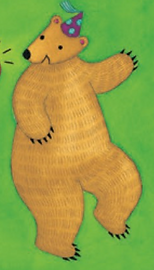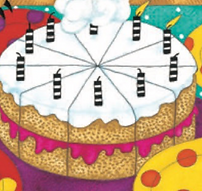Growing Independence and Fluency Design
Becoming Fluent with the Birthday Bear!
Rationale: This lesson is designed to improve students’ reading fluency. Reading fluently means that nearly all the words that a student is reading are a part of his or her sight vocabulary. As a result of this, the student is capable of reading at a fast and even pace without disturbing their reading comprehension. Fluency can make reading more gratifying for students because they learn how to read with more expression at a much smoother rate. Before students can reach a level of reading fluency, they must first demonstrate proficiency in decoding words. In this lesson, students will learn the strategies and skills that it takes to become a fluent reader through reading and rereading the story Bear’s Birthday.
Materials: Class set of Bear’s Birthday by Stella Blackstone, stopwatch or phone to time readings, pencil, cover-up critter, fluency checklist copies to give students, chart to record words per minute while reading, whiteboard, and dry erase markers.
Procedures:
1. First, the teacher will explain the concept of fluency to the class. The teacher might begin, “Good morning everyone! Today we are going to learn about what it means to become fluent readers. Can anybody guess what it means to have reading fluency?” After calling on several students, the teacher should explain that "fluency is when students develop many words in their sight vocabulary. Having a big sight word vocabulary means that you will know lots of words immediately while you read, which will help you improve your reading speed, vocabulary, expression, and smoothness. All of these things will help you to focus more on understanding the meaning of the passage! So, what does a fluent reading look like? When fluent readers read a passage, they can understand what the story is about and use lots of emotion when they are reading aloud. Fluent readers can also finish a passage quickly without making errors or long pauses. Today we are going to work on becoming fluent readers!"
2. Say: “We have cover-up critters to help us decode, which means to read an unfamiliar word by using the letters to match the sounds in the word. Let’s try the word bear as an example (write the word on the whiteboard). I am going to use my popsicle stick as a cover-up critter to decode the word bear. I will first cover up all of the latter except the first one, b. /b/.../b/.../b/. Next, I will uncover the e. /e/../e/.../be/. Last, I will uncover the ar and blend the phonemes together. /b/.../e/.../ar/.../bear/. This is the word bear. Let’s use it in a sentence: “Bear is having a birthday party.” While that sentence is true in our story, we know that bears don’t actually have birthday parties in real life.
3. Next, I will model the difference between fluent reading and non-fluent reading. I will write the sentences, “Bear and his friends played games, opened gifts, and ate lots of treats for his birthday.” I will read them very slowly at first to show how a non-fluent reader would read the sentences. “Bb-ee-aa-rr and his ff-rr-ii-ee-nn-dd-ss played games, opened gifts, and ate lots of tt-rr-ee-aa-tt-ss (/trets/) for his bb-ii-rr-tt-hh-dd-aa-yy. Oh! That word must be treats, not /trets/. (Explanation: Tell the students the treats is another name for desserts and ask their favorite treat). For this first demonstration, I will read in a monotone and halting manner that will seem off-putting to the students. I will explain that the books we will read to practice fluency should be on a level that students can succeed at, so they should not have to decode more than one or two words in a sentence. Then, I will read it two more times with increasing fluency, with increased speed, smoothness, and expression to show how a fluent reader would read the sentence. “Bear and his friends played games, opened gifts, and ate lots of treats for his birthday.” Then I will ask the students, “Did anyone notice any differences in the three readings of these sentences? Could you tell one was quicker and smoother than the others? I bet the reading you liked best was the most fluent reading, so we are going to practice our fluent reading skills today! I want you to try and read more quickly and with more expression each time we read the story!”
4. Say: “I want you to read the book Bear’s Birthday by Stella Blackstone at your seat. This story is about a bear and it is his birthday, so he is having a party! He decorates his house and all his bear friends come over. They play lots of games and Bear opens his presents. They also had a lot of treats like jam, honey, cake, and fruit! At the end of the story you can help Bear count all his balloons!
5. After the students read silently, I will then pair them up with partners. Say: “You and your partner will now get a stopwatch, a copy of Bear’s Birthday, a reading rate chart, and a fluency checklist. You and your partner are each going to read three times. You will each take turns being the reader and being the timer. The timer will time the reading and record the times on their reading chart and the reader will focus on their fluency each time. When it is your job to be the timer, be sure that you hit start as soon as your partner starts to read and hit stop as soon as they are done reading! Record all three of the times on your chart. After your partner has finished reading each time, you should fill out the fluency reading checklist and the reading rate chart. Filling these charts out will help your partner determine what aspects of their fluency are improving. After each reading, I want you to give your reading partner a special compliment about how their reading improved! This part is very important! You can compliment your partner on their speed, expression, smoothness, or their ability to remember the hard words from before.” Before the students start reading, I will model how to fill in the chart and use a stopwatch. I will then observe the students reading the book and will walk around the room as they read. I will answer any questions the students may have and make sure that they are filling in the correct time.
Checklist: First two questions can be filled out by the students, second two by the teacher.
STUDENT:
Did he/she remember more words? Read faster? Read smoother? Or read with more expression?
Did he/she read with emotion? This could be changing their face or voice!
TEACHER:
Did he/she reach the goal of 85 wpm? Did they improve?
Does the student have an overall understanding of what it means to be fluent and why it is important?
Fluency checklist will be filled out for each reading partner:
Title of Book:
Student’s Name:
Partner's Name:
Make a check if the following is true after the 2nd and 3rd Readings:
· Remembered more words:
· Read faster:
· Read smoother:
· Read with expressions:
Reading Tracker: The Reading Tracker buddy will be a picture of Bear dancing toward his birthday cake. Will he make it to get a slice?
0 - - - - 10 - - - - 20 - - - - 30 - - - - 40 - - - - 50 - - - - 60 - - - - 70 - - - - 80 - - - - 90 - - - - 100
Correct Words Per Minute:
6. After the students are done reading, I will collect the data. I will use it to analyze and assess how my students did and identify who might need extra practice. When I combine this data with the observations I made during the activity, I should not have any problems evaluating the progress of each child. If time permits, I will read with each student individually. If not, I will pull students having problems aside for extra practice. In one-on-one readings, I can mark improvements, areas of weakness and miscues, and ask comprehension questions to my students.
Comprehension Quiz:
1. Why did Bear blow up balloons?
2. What games did the bears play?
3. What was Bear’s favorite gift?

Reference:
Emma Griffin - Picking Up Perfect Fluency with Olivia the Pig!: Growing Independence and Fluency Design
https://emily-marie-griffin.weebly.com/growing-independence-and-fluency-design.html
Book:
Blackstone, Stella. Bear's Birthday, 2011.
https://www.getepic.com/app/read/71811
Reading Tracker Pictures:

